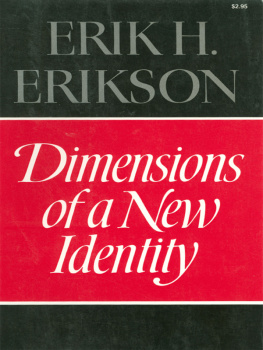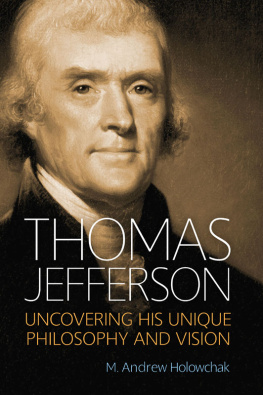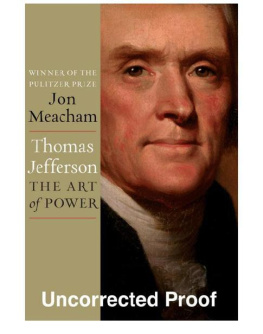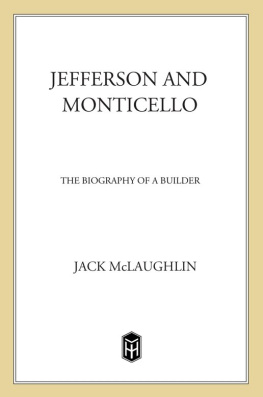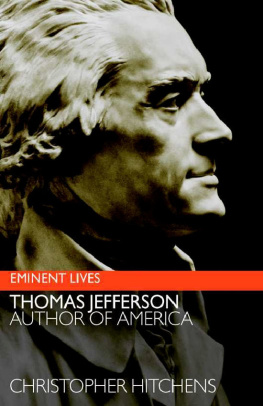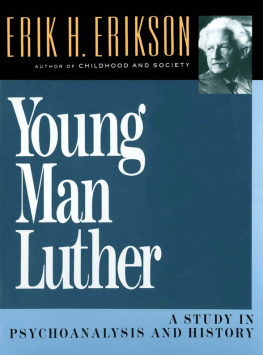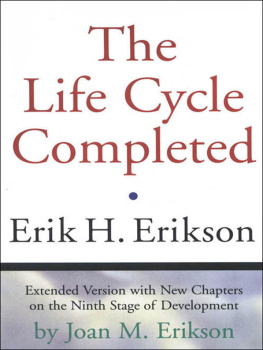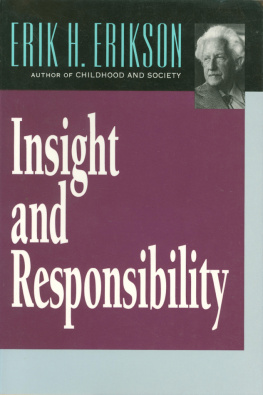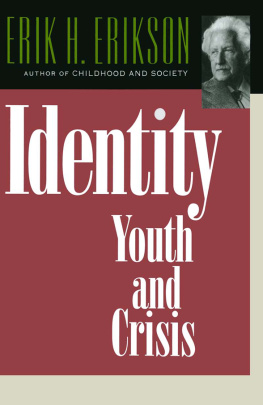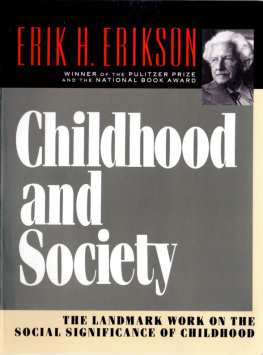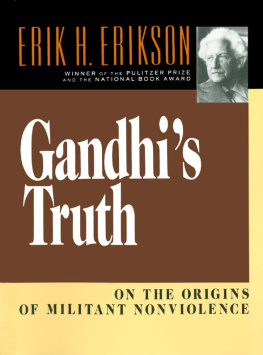
BY ERIK H. ERIKSON
Childhood and Society (1950, 1963)
Young Man Luther (1958)
Insight and Responsibility (1964)
Identity: Youth and Crisis (1968)
Gandhis Truth (1969)
Dimensions of a New Identity (1974)
In Search of Common Ground (1973)
(with Huey P. Newton and
Kai T. Erikson)

Copyright 1974 by W. W. Norton & Company, Inc.
First Edition
Library of Congress Cataloging in Publication Data
Erikson, Erik Homburber, 1902
Dimensions of a new identity.
(Jefferson lectures in the humanities, 1973)
1. Jefferson, Thomas, Pres. U.S., 17431826.
2. Identity (Psychology) I. Title. II. Series:
Jefferson lecture in the humanities, 1973.
E332.2.E74 973460924 [B] 7322289
ISBN 0393055159
All Rights Reserved
Published simultaneously in Canada
by George J. McLeod Limited, Toronto
Printed in the United States of America
Typefaces used are Janson and Deepdene.
Manufacturing was done by Vail-Ballou Press, Inc.
ISBN 978-0-393-34737-1 (e-book)
W HEN THE National Endowment for the Humanities announced a yearly Jefferson lecture, it attached to the occasion, besides the illustrious name, expectations which are beyond the hope of fulfillment of any but a very few individuals, be they from a scholarly, creative, public, or scientific walk of life. These expectations range from humanistic insights of importance to living issues as the test of humane learning. A visit from the then acting chairman of the Endowment, Wallace Edgerton, set my apprehensions sufficiently at rest so that, in preparation for the lectures, I could permit my mind to wander over issues prominent in Jeffersons life and sayings which were, at the time, also essential to further clarification in my area of work.
In the Washington of May Day, 1973, however, when the first lecture was delivered, humanistic insights and public issues (at least of the more sensational kind) seemed to have parted ways as never before, and this in a striking inner-political sequence to the nations division over the war in Southeast Asia. Predictably, some of the audience of the Jefferson lectures expected a clarification of living issues as contemporary as the day before and after. I deemed it inadvisable, however, to let short-range perspective dictate the nature of the Jefferson lectures, especially since I found it difficult enough to fit the thoughts prepared into the time allotted. Since then the long-range convergence of contemporary concerns with my main themes has become clearer and I have attempted to spell this out as I enlarged the lectures for this printed version. I have endeavored, however, for the most part to maintain a spoken rather than a written style. These, then, are still two lectures given on successive evenings. In order to interrupt such a lengthy discourse (as speakers are in a position to do, when with a sudden, alert Ladies and Gentlemen they manage to reawaken both the audience and themselves) I have provided my text with subtitles. I hope that this will allow the readers to shift in their chairs and to join me in periodic new starts from different perspectives.
As personal an experience as the Jefferson lectures are for the lecturer, they are part of a yearly occasion: This year the Endowment brought together its national representatives and legislative sponsors. I want to express my thanks to the chairman, Dr. Ronald S. Berman, and his staff for the way in which they helped me to play a central, if passing, role on one such impressive occasion. If my lectures make a limited contribution from the standpoint of a particular lifework, subsequent speakers will amplify and give perspective to earlier ones, and the whole lectureship become a lively addition to the Endowments work, so essential for our national life.
I N FAIRNESS to the Endowment, I should first of all declarewith my gratitude for this invitationmy awareness of the fact that Thomas Jefferson was to be the guiding spirit of these lectures, but by no means necessarily the subject. Yet, I was drawn to take a new look at Thomas Jefferson, and (as I should have known) once you look at him, it is impossible to get around him. But, as the best have found out, it is equally hard to get at him. Jeffersons image, it has been said often enough, has so many facets that I must begin by paraphrasing John F. Kennedys famous remark, made to an assembly of Nobel Prize winners in the White House, that no equally extraordinary collection of talent, of human knowledge had been gathered there since President Jefferson dined alone. One could say with equal justice that, brilliantly studied as he has been by devoted scholars (and, of course, also hastily analyzed by many more occasional reviewers), this man still walks through time as an enigmatic figure whose image is amplified as successive generations attempt to behold him. I consider myself, then, a witness before a perpetual assembly of scholars, feeling called upon to represent a particular viewpoint dictated by a circumscribed competence as an American and a professional.
I am an immigrant belatedly catching up with what (supposedly) every American youngster learns in school about this countrys history. And yet, there is much about Jeffersons transplantation of a classical stance to this continent which my humanist education in Europe prepared me to appreciate. But I am also an old man who in speaking tonight realizes that the theoretical orientation he brought with him from Europe has taken on in this country a direction which, for whatever it is worth, could have taken root only here: Wherefore my title, unashamedly, connects my identity concepts with this occasion.
And finally, there is an issue to be settled. I am a psychoanalyst and, as some of you know, my name is often associated with the term psychohistory. Now, I would wish it understood from the outset, that I have come to use this term only with tacit quotation marks. For while the unadorned term on early occasions came rather naturallyas once did psychobiology or psychosomatics until we found that such terminology perpetuates the very split it means to denyI would not wish to associate myself with all that is done in the name of this term. Therefore, a few brief words on methodology seem indicated so that I can proceed to tell you in my own way how I would go about approaching a historical figure like Jefferson.
Psychohistory, essentially, is the study of individual and collective life with the combined methods of psychoanalysis and history. In spite of, or because of, the very special and conflicting demands made on the practitioners of these two fields, bridgeheads must be built on each side in order to make a true span possible. But the completed bridge should permit unimpeded two-way traffic; and once this is done, history will simply be history again, but now a history aware of the fact that it has always indulged in a covert and circuitous traffic with psychology which can now be direct, overt, and aware. By the same token, psychoanalysis will have become conscious of its own historical determinants, and case history and life history will no longer be manners of speaking. The way you take history is also a way of making history.
Because of the clinical origin of psychoanalysis, however, what is now called psychohistory often tends to resemble a case history. A genuine case history gives an account of what went wrong with a person and of why the person fell apart or stopped developing; it attempts to assign to the particular malfunctioning a diagnosis in line with the observers psychodynamic views; and it arrives at therapeutic suggestions as to what could or can be done to reactivate a sounder development in this and in similar cases. A life history, in contrast, describes how a person managed to keep together and to maintain a significant function in the lives of others. The hero of a life history, of course, usually has a chronic neurotic conflict as a significant function in the lives of others. The hero of a life history, of course, usually has a chronic neurotic conflict as a significant part of his whole make-up but he becomes a case only insofar as the conflict has him.
Next page
